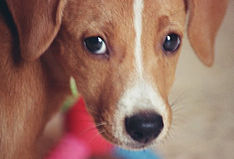Urinary incontinence is the involuntary leaking of urine, often times occurring when a pet is sleeping or relaxed. It is important to differentiate this from behavioral urinary issues such as submissive urination, territorial marking, loss of housetraining due to age, or cognitive dysfunction.
Causes
Urinary tract infections – can be diagnosed by microscopically evaluating a urine sample.
- Urine cultures can help determine the exact type of bacteria present and which antibiotics would work best to treat the infection.
- Treatment with antibiotics usually effectively improves comfort and incontinence after just a few doses.
Excessive water consumption – can cause the bladder to overflow resulting in involuntary leakage of urine.
- Many conditions can result in overdrinking water; these include but are not limited to: Cushing’s disease, diabetes, kidney disease, and behavioral causes.
- Determining the cause will involve checking blood chemistries, a complete blood count and urinalysis. Results of these tests are typically available within 3-5 days.
- Treatment would then be determined based on which condition is diagnosed.
Urethral sphincter incompetence – can be caused by aging, obesity, or less likely due to neurologic conditions like bulging discs or degenerative myelopathy. Development of weak bladder sphincter muscles is very common in female dogs, up to 1 in 5 are affected.
Treatment
Estrogen supplementation (DES) – a higher dose is used initially then reduced down to the dose needed to maintain its effectiveness. The low doses used for incontinence are usually well tolerated. However, side effects can include; transient vaginal bleeding and bone marrow suppression.
Phenylpropanolamine (PPA) – this medication is given orally twice to three times daily to effect. Side effects are infrequent but can include: restlessness, irritability and elevations in heart rate or blood pressure.
Surgical therapies and collagen injections are available through boarded surgeons at referral facilities. Unfortunately, 50 % of dogs receiving these surgeries still require the use of medication to completely control their incontinence.
Other Options
Occasionally medical treatments are not desired. In this case, diapers and/or sanitary pads are available through various manufacturers in female and male styles. Each pet depending on size, activity level, and frequency/quantity of urinary incontinence may require a different diaper style. Try a few different varieties to find what will work best for your pet. Side effects of diaper use can include irritation or infections. For suggestions ask our veterinary team.

